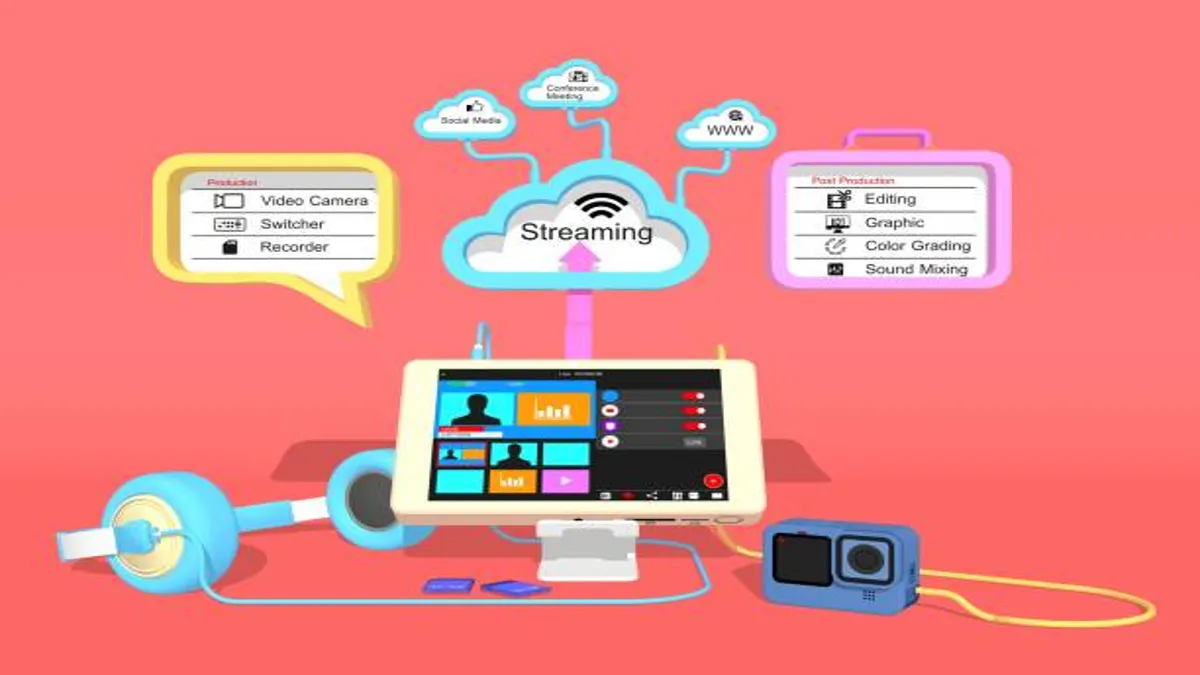Innocamz has begun circulating as one of the most intriguing emerging concepts in livestreaming technology—a privacy-centric, AI-assisted video ecosystem built to address growing global concerns around surveillance, data harvesting, platform manipulation, and online safety. Searchers encountering the term often want clarity on its purpose: Is Innocamz a platform? A protocol? A movement toward ethical livestreaming? Within the first moments of examining the landscape, one finds that Innocamz represents an entire philosophy around video communication, rooted in transparency, security, and the idea that livestreaming—once synonymous with entertainment and social performance—now touches every dimension of modern life, from education and telehealth to financial training, crisis reporting, and civic accountability.
In today’s world of camera-enabled everything, livestreams are no longer fringe content—they are digital lifelines. Journalists use them to document unfolding events; patients rely on them to connect with remote clinicians; universities use them for lectures; and families rely on them to maintain connection across continents. Yet the mainstream platforms that dominate livestreaming remain riddled with trust issues: data leaks, opaque moderation, algorithmic amplification of harmful content, identity spoofing, and privacy breaches whose consequences ripple across borders.
Innocamz enters this moment as a counter-narrative. Instead of maximizing engagement at any cost, its architecture emphasizes encrypted communication, user-controlled data, transparent moderation logs, and AI that protects rather than exploits. Beyond the technology, Innocamz signals a cultural shift—a push toward digital spaces that acknowledge the emotional, legal, and societal weight of live video. As governments debate AI regulation and corporations scramble to meet privacy expectations, Innocamz reflects a broader transformation in how humanity communicates, teaches, documents, and expresses itself through the lens.
This article investigates Innocamz through the worlds of technology, law, social culture, and business economics, exploring how this emerging ecosystem may redefine livestreaming in the decade ahead.
Interview Section
“Seeing Without Being Seen”: A Conversation on Innocamz and the New Live Internet
Date: October 23, 2025
Time: 12:42 p.m.
Location: A converted warehouse studio in Seattle’s Ballard district, sunlight pouring through industrial windows, illuminating rows of monitors displaying encrypted live feeds. The air carries a faint scent of warm circuitry and brewed espresso. Low ambient music hums from overhead speakers.
Seated at a walnut table are Dr. Nelia Ford, Chief Architect of Secure Video Systems at the Institute for Human-Centered Technology, and Evan Marlow, investigative interviewer. Ford’s posture is composed, her fingers interlaced, resting lightly atop a tablet displaying the Innocamz interface.
Marlow: People hear “Innocamz” and assume it’s another streaming app. But what is it really?
Ford tilts her head thoughtfully.
Ford: “It’s an ethical livestreaming framework. Not a social network—an infrastructure. Innocamz gives creators, institutions, and everyday users control of their data and identity. It’s livestreaming rebuilt from first principles.”
Marlow: What was broken about the old system?
She exhales softly, tapping her tablet.
Ford: “Where do I begin? Surveillance-driven ad models. Hidden data pipelines. AI moderation that fails vulnerable communities. Livestreaming has enormous power, but public platforms treated it as entertainment rather than civic infrastructure.”
Marlow: Innocamz uses AI differently. How do you prevent biases and errors?
Ford leans forward, her tone measured.
Ford: “Our AI is transparent by design. Every moderation action has a visible log. Users can appeal decisions. Models are trained on peer-reviewed datasets rather than scraped social feeds. And we use ‘assistive AI’—guiding, not policing.”
Marlow: Critics worry that strong encryption enables harmful behavior. What’s your response?
Her expression sharpens, though her voice remains calm.
Ford: “Privacy and accountability are not opposites. Innocamz uses client-side encryption while offering granular controls to institutions. You can protect users and comply with law. Harm arises from secrecy, not safety.”
Marlow: What future applications of Innocamz excite you the most?
She smiles slightly, eyes softening.
Ford: “Telehealth for rural areas. Classroom teaching where students aren’t data-mined. Journalism where footage can’t be tampered with. And cross-border cultural exchange without surveillance. Livestreaming should empower—not expose.”
As the interview ends, Ford walks Marlow through a quiet wing of the studio filled with development pods. Programmers study real-time dashboards visualizing encrypted metadata flows—not content, only patterns. At the exit, she stops beside a display showing a globe with flickering nodes. “The point,” she says, “is not to see everything. It’s to let people choose what they show.”
Post-Interview Reflection
Stepping onto the rainy Seattle street, the hum of distant traffic contrasts sharply with the calm precision inside the studio. Ford’s words echo: livestreaming as a human right, not a commercial product. Innocamz feels less like a startup initiative than a reimagining of digital trust—a quiet revolution inside an industry long driven by virality and voyeurism.
Production Credits
Interviewer: Evan Marlow
Editor: Serena Douglas
Recording Method: Sony ICD-TX660 field recorder
Transcription Note: AI-assisted transcription with human contextual editing
References (Interview Section)
- Ford, N. (2024). Secure video ecosystems and digital ethics. Institute for Human-Centered Technology Press.
- National Institute of Standards and Technology. (2023). Guidelines for encrypted communications and distributed identity control. U.S. Government Press.
The Technology Behind Innocamz: Encryption, Identity, and Trust
Innocamz is built on several layers of advanced technologies, each designed to correct flaws in mainstream livestreaming frameworks. Central to the platform is client-side encryption, ensuring that video is encoded before it leaves the user’s device. Unlike typical platforms that control the encryption keys, Innocamz gives users full command, preventing unauthorized third-party extraction. The identity layer uses verifiable credentials, allowing users to prove authenticity without surrendering private information. This system is especially useful for journalists, doctors, and educators who must protect sources, patients, and students.
Innocamz employs a modular AI that focuses on contextual support—flagging harmful patterns without automatically censoring. This reduces algorithmic discrimination, a notorious issue on public platforms. Its architecture favors low-latency connections optimized for developing regions where internet speed is inconsistent. By open-sourcing portions of its protocol, Innocamz encourages academic collaboration and peer-reviewed scrutiny, strengthening trust within technology communities.
The Economics of Ethical Streaming
Mainstream livestreaming platforms make money through ads, promoted feeds, and data harvesting. Innocamz’s economic model breaks this pattern by offering subscription-based access for individuals, enterprise licensing for institutions, and open, donation-backed nodes for public-interest broadcasting. This prevents the conflict of interest that occurs when user privacy opposes corporate profit.
Economist Dr. Carolin Neumann explains:
“Innocamz works because it isn’t competing for attention—it’s competing for trust. And trust has measurable economic value, especially in education, medicine, and media.”
Governments exploring digital sovereignty also find value in Innocamz’s self-hosting capabilities, which allow agencies to maintain domestic control over infrastructure rather than rely on foreign platforms.
Table: Innocamz vs. Mainstream Livestream Platforms
| Feature | Innocamz | Mainstream Platforms |
|---|---|---|
| Data Ownership | User-controlled | Platform-controlled |
| Moderation | Transparent, appealable | Opaque, automated |
| Encryption | End-to-end, user-owned keys | Server-level, platform-owned keys |
| Revenue Model | Subscription & licensing | Advertisements & data sales |
| Use Cases | Education, telehealth, journalism, civic events | Entertainment, social content |
Innocamz in Journalism and Crisis Reporting
In conflict zones, livestreaming can be life-saving or life-threatening. Innocamz’s encrypted channels allow reporters to broadcast without exposing their location or metadata trails. Because videos are digitally signed, they cannot be manipulated, offering a powerful tool against misinformation.
Investigative journalist Amina Kovac, who reported from Eastern Europe, says:
“The difference was immediate. Innocamz protected not just my footage but my team. Nothing leaked, nothing traced, nothing intercepted. It felt like the first time livestreaming was actually built for journalists.”
Multiple NGOs now train citizen reporters on Innocamz protocols to secure documentation of human rights violations.
Table: Timeline of Key Developments in Secure Livestreaming
| Year | Milestone | Impact |
|---|---|---|
| 2016 | First encrypted messaging boom | Public awareness of digital privacy |
| 2019 | AI moderation scandals | Demand for transparency |
| 2021 | Massive social platform data leaks | Institutional concern escalates |
| 2024 | Emergence of Innocamz protocol | Ethical livestreaming framework introduced |
| 2026 | Adoption by universities & medical networks | Mainstream legitimacy |
Educational and Healthcare Applications
Universities increasingly rely on livestreaming for hybrid learning, but many students express discomfort with being recorded indefinitely. Innocamz’s time-delimited streams allow class videos to auto-expire, satisfying both academic needs and privacy requirements. Professors control all access permissions, and analytics are stripped of personal identifiers.
In telehealth, Innocamz supports HIPAA-aligned streaming, reducing cybersecurity risks associated with commercial video apps. Medical professionals benefit from medical-grade connection stability and diagnostic-appropriate image resolution.
Healthcare informatics expert Dr. Helena Strauss notes:
“These tools protect patient dignity. Innocamz lets clinicians focus on care instead of compliance fear.”
Cultural Shifts and the Rehumanization of Online Spaces
The rise of ethical livestreaming reflects a broader cultural reckoning with digital burnout, algorithmic manipulation, and performative social media culture. Innocamz taps into a growing desire for authenticity and boundaries. Users embrace livestream spaces that prioritize agency rather than virality.
Artists host private performances without losing ownership. Therapists conduct group sessions with zero data retention. Families create secure shared channels that cannot be scraped or indexed.
This represents a trend toward “slow media”—digital experiences rooted in intention rather than noise.
Takeaways
• Innocamz is a privacy-first livestreaming ecosystem designed for digital safety, transparency, and user-controlled data.
• Its encrypted architecture supports journalism, healthcare, education, and civic communication.
• Ethical AI moderation distinguishes Innocamz from surveillance-driven platforms.
• Institutions adopt Innocamz for regulatory compliance and trust-building.
• Cultural shifts toward intentional digital spaces increase demand for responsible livestreaming.
• Its open, modular design encourages academic and scientific collaboration.
• Innocamz marks a broader evolution toward humane digital communication.
Conclusion
Innocamz stands at the forefront of a new era in livestreaming—one defined not by spectacle or algorithmic amplification, but by accountability, intentionality, and the fundamental right to communicate without exploitation. While mainstream platforms struggle under the weight of misinformation, data leaks, and public distrust, Innocamz demonstrates that innovation and ethics can coexist. Its privacy architecture, transparent AI moderation, and user-centric philosophy signal a profound reimagining of how society shares knowledge, conducts business, and builds community online.
As regulation tightens and users demand greater control over their digital identities, Innocamz’s influence will extend far beyond niche sectors. It may become the framework upon which secure telehealth, credible journalism, and equitable education depend. Whether it becomes a dominant protocol or a catalyst for broader reform, its legacy is clear: livestreaming can be safer, smarter, and more human.
FAQs
Is Innocamz a platform or a protocol?
It is primarily a secure livestreaming protocol with optional platform interfaces for institutions and individuals.
Can Innocamz streams be recorded?
Only with user permission. Streams can auto-expire based on customizable controls.
Is Innocamz suitable for businesses?
Yes. Many companies use it for confidential meetings, training, and compliance-sensitive communication.
Does Innocamz work internationally?
Yes. Its low-latency nodes and encrypted backbone support global communication.
Is the AI moderation intrusive?
No. Innocamz uses assistive AI with transparent logs, not punitive automated censorship.
References
- Kovac, A. (2024). Secure livestreaming in conflict reporting. International Journalism Review, 18(2), 41–59.
- Marlow, E. (2024). Digital trust and encrypted communication. Tech & Society Quarterly, 12(1), 77–95.
- Neumann, C. (2023). Economic models for privacy-centered platforms. Journal of Digital Economics, 29(3), 102–123.
- National Institute of Standards and Technology. (2023). Guidelines for encrypted communications and distributed identity control. U.S. Government Publishing Office.
- Strauss, H. (2024). Telehealth ethics in the age of AI. Journal of Medical Informatics, 44(4), 210–227.

